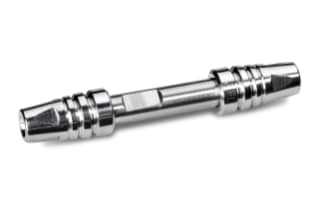
|
Separation Mode |
SuperCritical Fluid (SFC) |
|
Particle Substrate |
Hybrid |
|
Maximum Pressure |
6000 psi (415 Bar) |
|
Endcapped |
No |
|
Silanol Activity |
Medium |
|
Particle Shape |
Spherical |
|
Particle Size |
1.7 µm |
|
Endfitting Type |
Parker-style |
|
Pore Size |
130 Å |
|
Format |
Column |
|
Surface Area |
185 |
|
System |
SFC, UPC2 |
|
Particle Technology |
BEH |
|
Technique |
SFC, SFC/MS |
|
Inner Diameter |
3 mm |
|
Length |
50 mm |
|
eCord |
Yes |
|
UNSPSC |
41115711 |
|
Brand |
Viridis |
|
Product Type |
Columns |
|
Units per Package |
1 pk |
Viridis BEH Column, 130Å, 1.7 µm, 3 mm X 50 mm, 1/pk
The Viridis sub-2µm and 3.5µm columns, designed and tested for the ACQUITY UPC2 system, offer exceptional efficiency and resolution. Even for well-retained basic achiral compounds, the decrease and control of surface silanol activity on Viridis particles produces good peak morphologies under SFC conditions – without the need for mobile-phase additives.
Viridis Columns add achiral SuperCritical Fluid (SFC) selectivities to the mix. Ethylene Bridged Hybrid (BEH) particle technology, Charged Surface Hybrid (CSH) particle technology, and High-Strength Silica (HSS) particle technology are all available types in these columns. BEH is the basis for the lab equipment listed here. Under SuperCritical Fluid (SFC) conditions, the reduction and regulation of surface silanol activity on Virids particles produces outstanding peak geometries, especially for well-retained basic achiral compounds.
With the right lab equipment, you can boost your productivity. You can browse our website and refer to our catalog to shop for lab equipment to replace your stock and add to your existing equipment portfolio. You can also locate different products that are compatible with the analytical column, such as the Viridis BEH Column described here. You can shop for lab equipment on our website and contact us with any queries you may have. You can contact a member of our staff in one of our global offices across the world with your questions and concerns.
You may also be interested in TruView LCMS Certified Clear Glass 12 x 32 mm Screw Neck Vial, with Cap and Preslit PTFE/Silicone Septum, 2 mL Volume, 100/pk; TruView LCMS Certified vials are produced following tightly controlled manufacturing processes and handling procedures. They are tested for cleanliness by mass spectrometers and for low analyte adsorption by ACQUITY/MS/MS.
Why Does My LC System Keep Constantly Shutting Down?
HPLC pumps and systems have overpressure protection built in to ensure system safety and protect the columns and equipment. If the system is set too low or there is too much back pressure, the pump may shut off to safeguard the LC system. Cleaning the lines or removing leftover or crystallized material that is clogging or choking the system could be other explanations.
What Considerations Must Be Made When Preparing Samples?
Samples may contain buffers and leftover reagents from authorized digesting procedures. Other reagents, denaturants, detergents, and lipids, as well as particles, must be removed from the sample. Samples containing a significant amount of undigested protein per injection have been shown to limit or reduce column lifetimes, depending on the injected quantity and column diameter. As a result, proper sample preparation techniques are essential.